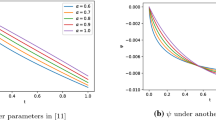Abstract
This paper examines the impact of the joints tails of the portfolio return and its empirical volatility on the optimal portfolio choices. We assume that the portfolio return and its volatility dynamic is approximated by a bivariate Markov chain constructed on its historical distribution. This allows the introduction of a non parametric stochastic volatility portfolio model without the explicit use of a GARCH type or other parametric stochastic volatility models. We describe the bi-dimensional tree structure of the Markov chain and discuss alternative portfolio strategies based on the maximization of the Sharpe ratio and of a modified Sharpe ratio that takes into account the behaviour of a market benchmark. Finally, we empirically evaluate the impact of the portfolio and its stochastic volatility joint tails on optimal portfolio choices. In particular, we examine and compare the out of sample wealth obtained optimizing the portfolio performances conditioned on the joint tails of the proposed stochastic volatility model.







Similar content being viewed by others
Notes
We used the Matlab R2018b function ’pattersearch’. At each iteration, the 2n directions given by the canonical basis and its opposite are explored. Finally the closest point to the current solution which satisfies working set constraints and provide the best improvement of the objective function is selected as new current solution.
References
Angelelli, E., & Ortobelli Lozza, S. (2009). American and European portfolio selection strategies: the markovian approach, Chapter 5. In P. N. Catlere (Ed.), Financial hedging (pp. 119–152). Hauppauge, New York: Nova Science Publishers.
Bean, N. G., Kontoleon, N., & Taylor, P. G. (2008). Markovian trees: properties and algorithms. Annals of Operations Research, 160(1), 31–50.
Bollerslev, T. (1986). Generalized autoregressive conditional heteroskedasticity. Journal of Econometrics, 31(3), 307–27.
Canakoglu, E., & Ozekici, S. (2008). Portfolio selection in stochastic markets with exponential utility functions. Annals of Operations Research, 160(1), 281–297.
Cogneau, P., & Hübner, G. (2009a). The (more than) 100 ways to measure portfolio performance—part 1: special measures and comparison. Journal of Performance Measurement, 13(1), 56–71.
Cogneau, P., & Hübner, G. (2009b). The (more than) 100 ways to measure portfolio performance—part 2: special measures and comparison. Journal of Performance Measurement, 14(1), 56–69.
D’Amico, G., & Di Biase, G. (2009). Dynamic concentration /inequality indices of economic systems. In C. A. Bolucea, V. Mladenov, E. Pop, M. Leba, N. Mastorakis (Eds.),In proceedings of the international conference recent advances in applied mathematics, (pp. 312–316).
D’Amico G., Di Biase, G., Janssen, J., & Manca, R. (2009) Semi-Markov backward credit risk migration models compared with Markov models. In P. Pardalos, N. Mastorakis, V. Mladenov, Z. Bojkovic (Eds.), In proceedings of the 3RD international conference on applied mathematics, simulation, modelling, (pp. 112–116).
D’Amico, G., Di Biase, G., Janssen, J., & Manca, R. (2010). Semi-Markov Backward Credit Risk Migration. Models: a Case Study. International Journal of Mathematical Models and Methods in Applied Sciences, 4(1), 82–92.
Duan, J., & Simonato, J. (2001). American option pricing under GARCH by a Markov chain approximation. Journal of Economic Dynamics and Control, 25, 1689–1718.
Elliott, R. J., & Siu, T. K. (2010). On risk minimizing portfolios under a Markovian regime-switching Black–Scholes economy. Annals of Operations Research, 176(1), 271–291.
Engle, R. F. (1982). Autoregressive conditional heteroskedasticity with estimates of the variance of United Kingdom inflation. Econometrica, 50(4), 987–1007.
Fu, Y. H., Ng, K. M., Huang, B., & Huang, H. C. (2015). Portfolio optimization with transaction costs: a two-period mean-variance model. Annals of Operations Research, 233.1, 135–156.
Glosten, L. R., Jagannathan, R., & Runkle, D. E. (1993). On the relation between the expected value and the volatility of the nominal excess returns on stocks. Journal of Finance, 48(5), 1779–801.
Iaquinta, G., & Ortobelli Lozza, S. (2008). Markov chain applications to non parametric option pricing theory. International Journal of Computer Science & Network Security, 8(6), 199–208.
Nelson, D. B. (1991). Conditional heteroskedasticity in asset returns: a new approach. Econometrica, 59:2, 347–70.
Ortobelli Lozza, S., Angelelli, E., & Bianchi, A. (2011). Financial application of bivariate Markov processes. Mathematichal Problems in Engineering, 2011, 1–15. https://doi.org/10.1155/2011/347604.
Rachev, S., & Mittnik, S. (2000). Stable paretian models in finance. Chichester: Wiley.
Sharpe, W. F. (1994). The sharpe ratio. Journal of Portfolio Management, 21(1), 45–58.
Valladão, D., Silva, T., & Poggi, M. (2018). Time-consistent risk-constrained dynamic portfolio optimization with transactional costs and time-dependent returns. Annals of Operations Research, 176(1), 1–27.
Acknowledgements
The authors thank for grants ex-MURST 60% 2019, 2018. Rosella Giacometti acknowledges the support of the Czech Science Foundation (GACR) under Project 19-11965S.
Author information
Authors and Affiliations
Corresponding author
Additional information
Publisher's Note
Springer Nature remains neutral with regard to jurisdictional claims in published maps and institutional affiliations.
Rights and permissions
About this article
Cite this article
Bonomelli, M., Giacometti, R. & Ortobelli Lozza, S. Joint tails impact in stochastic volatility portfolio selection models. Ann Oper Res 292, 833–848 (2020). https://doi.org/10.1007/s10479-020-03531-w
Published:
Issue Date:
DOI: https://doi.org/10.1007/s10479-020-03531-w




